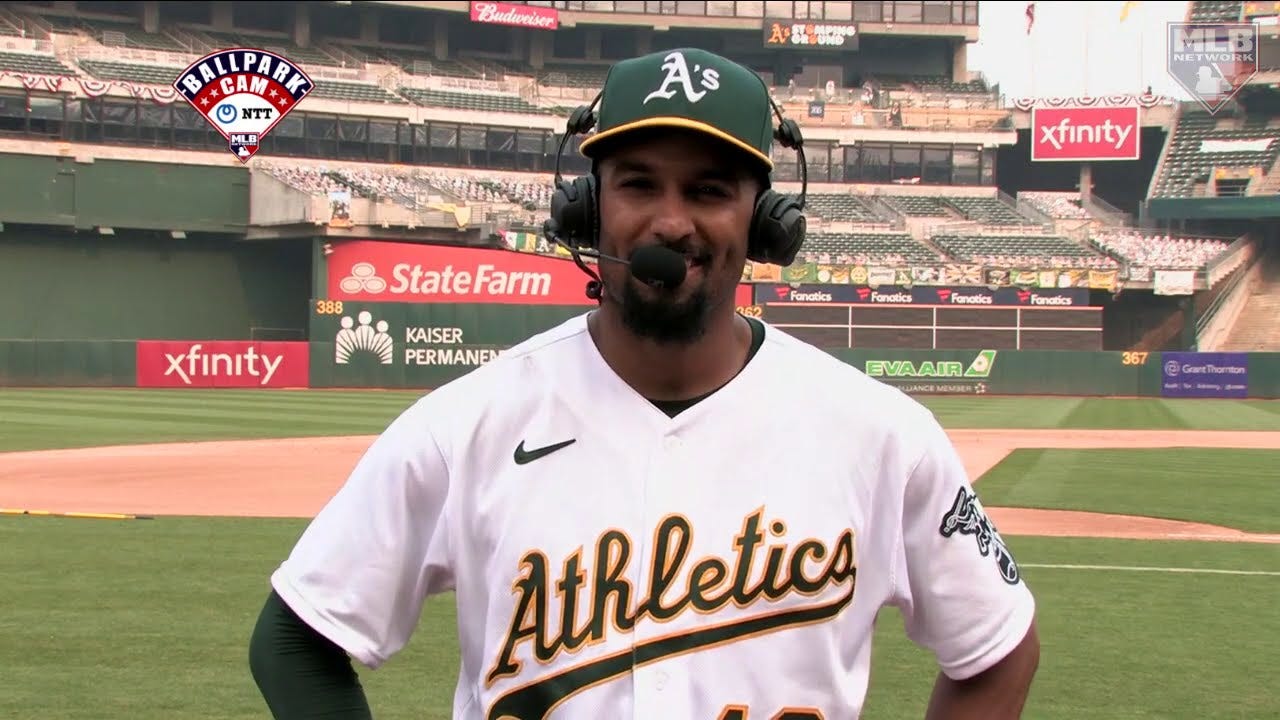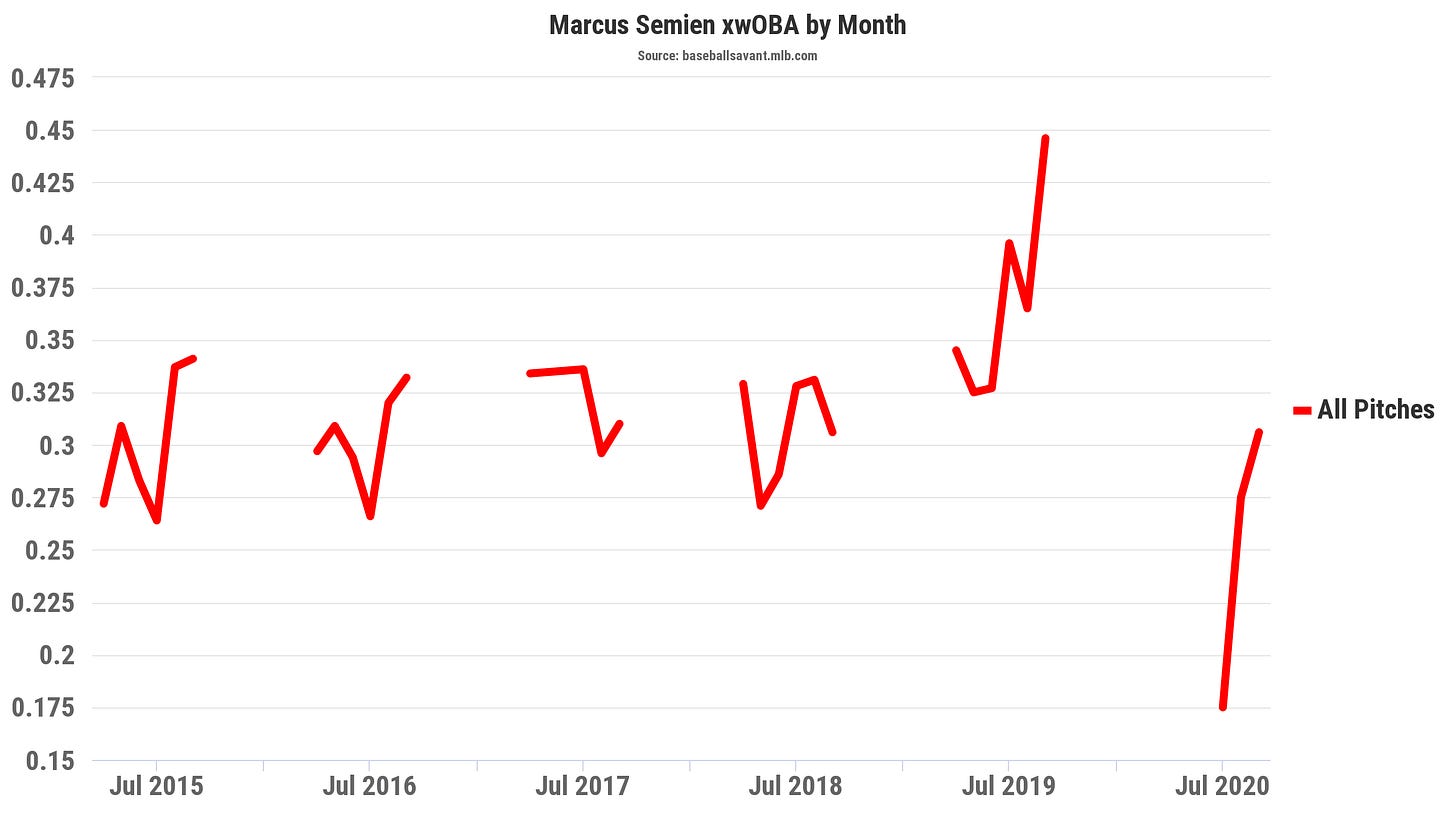OK, so was Marcus Semien a one-year wonder or what?
Digging into some numbers on the Blue Jays' new second baseman, whose 2020 paled in comparison to his MVP-calibre 2019.
I know this may be something of a stretch for a lot of readers but imagine, just for a second, that you’re a Blue Jays fan. Weird, I know, but just go with me here. OK, now imagine that back on Tuesday night you heard the big news: the Blue Jays signed former A’s shortstop Marcus Semien to a one-year, $18 million contract to play second base in 2021. Everybody outside of Oakland is elated! This is a huge score for the Jays and gives them a ridiculous lineup that will be able to outscore just about anybody.
Haha fuck yeah!!! Yes!!
Then you head on over to his FanGraphs page and you’re greeted with this.
“Fire Shatkins,” you whisper to yourself as you stare at the numbers of a hitter who has had one above average year then immediately turned back into a pumpkin.
Well this sucks. What the fuck.
Of course, if you are then keen enough to read a site like this one, you might have checked out my post on the news, where I passed on some important context for those 2020 numbers Semien put up from Craig Edwards of FanGraphs.
Because it’s just so darn comforting, here’s that passage again:
“A slow start had an oversized effect on the overall numbers. After 14 games, Semien had a 24 wRC+ and -0.2 WAR. Over his next 46 games, he put up a 133 wRC+ and 2.0 WAR — nearly identical to his great 2019 performance. His Statcast numbers back that up, with a .347 xwOBA after his first two weeks. In a normal season, maybe Semien has a rough couple weeks but gets hot in the middle of June and, with 100 games to go, is looking at a 4–5 WAR season heading to free agency instead of reaching it as the three-win player the market might treat him as.”
Part of the reason Semien is now a member of the Blue Jays is the fact that Edwards was precisely right when he wrote that back in November. The market wanted to treat Semien like a three-win player — if that! — so Semien decided that the Blue Jays’ offer of a high-priced one-year deal was a good way to position himself for another run at free agency next winter. One can safely assume that he believes that, if the 2020 season had continued for a full 162, his overall numbers would have looked a whole lot more like the great ones he put up over his final 46 games, not the ugly ones from his first 14.
A more skeptical fan, however, might wonder: if 60 games is an inadequate sample size, why should we put that much stock in a 46 game sample? Why should we believe Semien’s 2019 breakout was for real, and what is it, other than purely the results, that make us think those 46 games in 2020 demonstrate that he was the same hitter he was in 2019?
Good questions! Fortunately, we’re hardly the first people to have thought the question. Semien himself has certainly thought about what made his 2019 season different. He has a pretty interesting answer, too. He started using a smaller bat.
“Last season, Semien used a 34-inch bat. But this spring, he switched to 33.5 inches. He said the smaller bat made his hands feel quicker,” wrote Marcus Thompson II of the Athletic back in August of 2019. “Then, on June 7 in Arlington, Texas, he got a lighter version of the new bat, dropping down to 31.5 ounces. That night, Semien went 4 for 5 with two home runs and drove in four of the A’s runs in a 5-4 win over Texas.”
Semien decided to immediately stick with the bat, and his season took off.
An outstanding Twitter thread from last April by @StatBlastSports examined some of the statistical particulars surrounding this change.






On one hand, this makes it sound like Semien has been an elite hitter for even less time than looking at his year over year numbers had suggested. He was still about league average all the way until June 2019. But on the other hand, there’s a tangible reason for the change we see in his results, and it seems to be reflected in his improved ability to lay off pitches outside the strike zone.
Now let’s see what happens when we add 2020 to the graph in StatBlast’s tweet.
We can see how those 14 awful games at the start of 2020 affected his wRC+ a significant part of the “season.” We can also see, however, that the improvement in place discipline seemed to stick.
And if Semien’s goal of optimizing his launch angle was about more consistently putting the ball in the air, we can see by looking at his flyball and groundball rates that he both seems to have accomplished this and made it stick into 2020 as well.
Does any of this “prove” anything? Well, no. But we have three underlying numbers here — O-swing%, flyball rate, and groundball rate — that in 2020 looked a whole lot more like Semien’s 2019 than they did his previous seasons. And with the switch to the smaller and lighter bat, and the concerted effort to put the ball in the air more, we have some fairly sound explanations for the changes we see in the data.
Now, I can’t lie here. Semien’s hard hit rate and exit velocity did take a pretty good hit in 2020, and didn’t rebound after the rough start even though the results did. His Statcast numbers were even scarier than the ones from his pre-2019 seasons, his average exit velocity dipped from a career high of 88.9 mph to a career low of 86.2 mph, and in this case our concerns aren’t lessened by ignoring the early part of the season. He was pretty consistently around his average rate for the whole year.
That’s not super comforting, but fortunately, average exit velocity doesn’t always tell the whole story. Semien’s expected weighted on-base (xwOBA) definitely shows that the beginning of his 2020 season was a clear outlier relative to the rest of his career.
Also an outlier around that time, at least relative to improvements he’s made since mid-2018, was his strikeout rate.
Clearly neither his strikeout rate nor his xwOBA bounced back to their 2019 levels after his awful start to 2020, but if they had he wouldn’t have been available on a one-year deal and wouldn’t now be a member of the Blue Jays.
The fact that he’s putting the ball in the air more consistently is still a plus — especially moving from RingCentral Coliseum (which is apparently what they call the Oakland Coliseum these days) to the Rogers Center (which is apparently what they call the SkyDome these days) and the A.L. East in general. The improvements when it comes to laying off pitches outside the zone remain a great sign. The fact that he’s been an elite defender at shortstop and will now be shifting to second base (and, presumably at time, to third) is absolutely a plus. The fact that none of the numbers I’ve used here include Semien’s incredible playoff run — he slashed .407/.484/.667 over an additional 31 plate appearances, which if included in his season totals would have brought his wRC+ up to 107 — is yet another plus.
You weren’t wrong, my skeptical friend, to think that this whole enterprise may not be the slam dunk that some of Tuesday’s celebrations made it out to be. But there’s only one Mike Trout. Everybody else has some kind of a red flag or another, and the objective of every front office is to use the whatever information they have at their disposal make the best bets they possibly can with the players they acquire.
Taking on Semien is definitely a bet the Jays have made, but because of the changes he’s made over the last two years we can comfortably say that it’s not a bet on the player that he was prior to 2019.
And the great thing is, even if it doesn’t work out, it’s not like the Jays’ lineup will be lacking for firepower elsewhere. Go ahead be thrilled about your new second baseman.
Top image: Screengrab via MLB Network/YouTube











Is he better than Joe Panik, or Brandon Drury, or Travis Shaw, or whoever else the Jays threw out there last year? I'm comfortable saying yes. And it's not my money.
You know what they say, there is no such thing as a bad 1 year deal for players who were over 7 fWAR in their last full season. This feels like a slam dunk to me, can we just start the season already(after signing Walker)